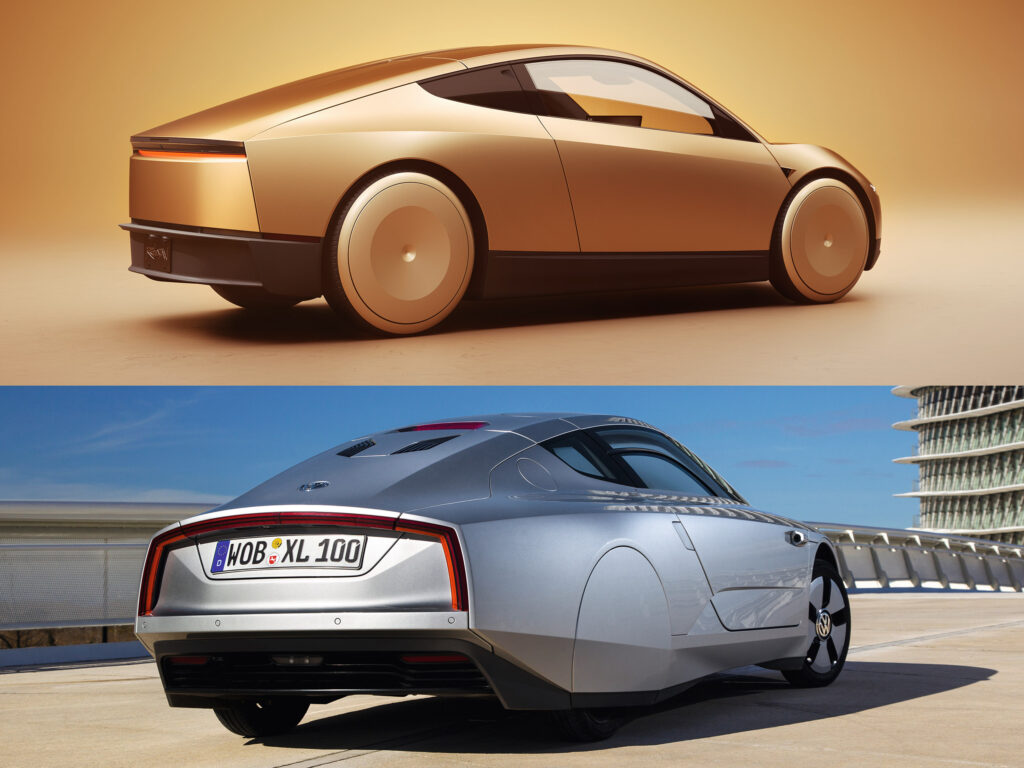5 Surprising Similarities Between Tesla’s Cybercab And VW’s XL1

- Tesla’s Cybercab is a driverless EV designed to revolutionize urban mobility with full autonomy and affordable mass production.
- The VW XL1 was an ultra-limited, fuel-efficient project that pushed the limits of hybrid technology and lightweight materials.
- Both models focus on aerodynamic efficiency, using futuristic design elements to improve overall performance.
When Tesla unveiled its futuristic Cybercab, many sharp-eyed observers were quick to spot an unexpected resemblance to an obscure eco-marvel from the past—the VW XL1. While Tesla’s latest creation wants to revolutionize urban mobility with full autonomy and mass-market ambitions, the XL1 was a hyper-efficient, ultra-limited experiment in fuel-saving technology. Despite their vastly different missions, the visual similarities between the two are hard to overlook.
Tesla’s Cybercab—or robotaxi, as it’s often called—is a fully electric, fully self-driving vehicle. Elon Musk has set his sights on starting production by 2027, with a projected price tag of $30,000. What sets the Cybercab apart is that it completely eliminates the steering wheel and pedals altogether, depending entirely on AI and a web of sensors to shuttle passengers to their destinations without human intervention.
Meanwhile, the VW XL1, a true unicorn in the automotive world, had a production run of just 250 units, all reserved for European buyers, with an eye-watering price tag of €111,000 (around $121,500 today). First introduced as a concept in 2002 that was refined in 2009 and 2011, the XL1 finally hit the market in 2013. Its headline feature? A mind-bending fuel consumption of just 0.9 liters per 100 km, or about 260 mpg. VW achieved this through a 0.8-liter, two-cylinder, plug-in diesel hybrid powertrain producing 68 hp, combined with cutting-edge lightweight materials and wind-cheating aerodynamics.
So, how did two seemingly unrelated vehicles—one an affordable robotaxi, the other an ultra-expensive eco-cruiser—end up looking like long-lost cousins? The most obvious explanation is their shared goal of aerodynamic efficiency, along with a desire to create something futuristic and desirable. Let’s break down the five key similarities that tie the Tesla Cybercab and VW XL1 together.
Silhouette

We start with the most obvious similarity, which is the overall shape. This is largely dictated by aerodynamics, as the droplet is the natural form with the least drag. The short nose and sloping roofline are common features among several concepts and production vehicles, but the effect is accentuated by the similar greenhouse design.
However, the XL1 pushes aerodynamics even further with its extended tail and rear wheel covers, designed to slice through the air with minimal resistance. In contrast, the Cybercab opts for larger disc wheels and a rising beltline that gives it a more approachable, less aggressive look.
Butterfly Doors

Another key feature of the Tesla Cybercab and the VW XL1 is their butterfly doors, contributing to their futuristic stance. Besides the cool factor, the design makes it easier for occupants to enter and exit the cabin, especially in low-slung vehicles. This is why you usually come across unconventional door mechanisms on supercars and hypercars rather than SUVs, with the notable exception of the Tesla Model X.
The XL1 takes this one step further by incorporating portions of the roof into the door design, necessary given the car’s ultra-low height of just 1,153 mm (45.4 inches). While Tesla hasn’t released detailed specs on the Cybercab’s height, prototypes appear significantly taller than the XL1, making this door style more about form than function.
No Rear Windscreen

Lighting Units
The omission of a rear windscreen is not as uncommon in 2024 as it was in 2013, but it’s another shared trait between the Tesla and the VW, contributing to the monolithic appearance of the rear deck. In the XL1, the lack of rear glass likely served weight and aerodynamic goals. For the Cybercab, fully autonomous driving eliminates the need for rear visibility altogether.
Interestingly, other new models, like the Avatr 12 and the Polestar 4, have also ditched the rear windscreen, marking a trend in modern automotive design that favors tech-driven solutions over traditional visibility.

This one might be a bit of a stretch, but both the Cybercab and XL1 boast full-width light bars on both ends that give them an undeniably sci-fi aesthetic, especially at night. While each model has its own distinct lighting signature, the Cybercab seems to take inspiration from Tesla’s notorious Cybertruck, blending angular, futuristic elements with clean, continuous light strips at both the front and rear.
Two-Seater Cabin

Finally, both models have a two-seater interior layout, despite not being geared towards high-performance driving. The Tesla Cybercab has the unique trait of omitting the driving controls (no steering wheel or pedals), while the VW XL1 features a notable offset between the seats, making the maximum use of its narrow cabin.
A clear advantage the Cybercab has over the tiny XL1 is cargo space. Thanks to its fully electric powertrain, Tesla had more room to play with packaging, giving the Cybercab a larger trunk. The XL1, on the other hand, had to make do with a rear-mounted 0.8-liter turbodiesel engine as part of its hybrid setup, limiting practicality.
And that concludes our list with the similarities between the fully electric robotaxi (Tesla Cybercab) and the highly efficient automotive oddity (VW XL1). Do you think that Tesla designers intentionally copied (or at least were influenced by) the Volkswagen, or are these features simply the byproduct of engineering for maximum efficiency and usability?
